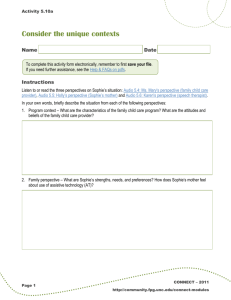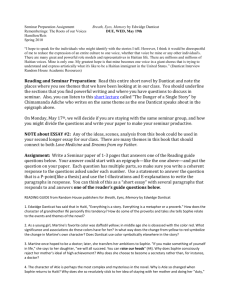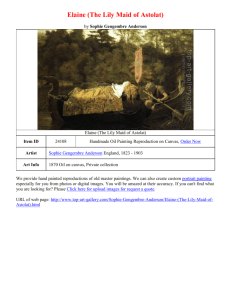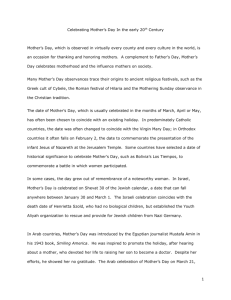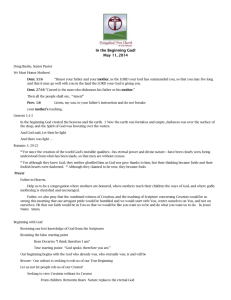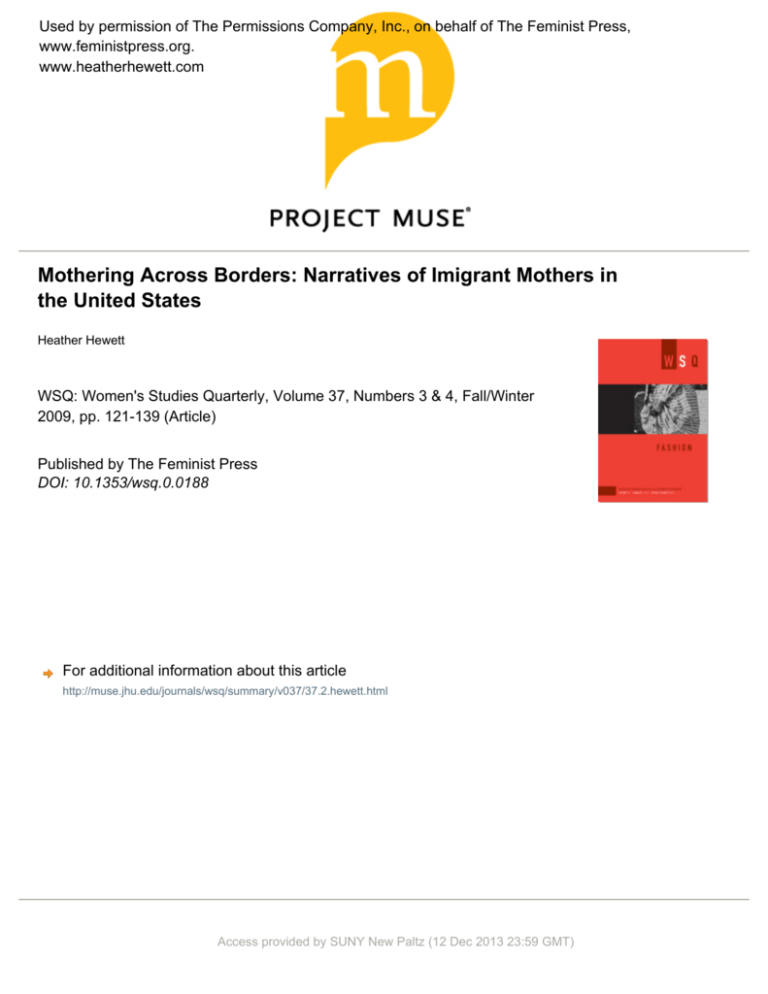
Used by permission of The Permissions Company, Inc., on behalf of The Feminist Press,
www.feministpress.org.
www.heatherhewett.com
Mothering Across Borders: Narratives of Imigrant Mothers in
the United States
Heather Hewett
WSQ: Women's Studies Quarterly, Volume 37, Numbers 3 & 4, Fall/Winter
2009, pp. 121-139 (Article)
Published by The Feminist Press
DOI: 10.1353/wsq.0.0188
For additional information about this article
http://muse.jhu.edu/journals/wsq/summary/v037/37.2.hewett.html
Access provided by SUNY New Paltz (12 Dec 2013 23:59 GMT)
Mothering Across Borders:
Narratives of Immigrant Mothers
in the United States
Heather Hewett
Over the past several decades, motherhood has gained a heightened visibility in U.S. popular culture. A combination of disparate phenomenon—the
increased media coverage of celebrity moms, the development of targeted
marketing strategies, the appearance of “mommy lit” and “mommy memoirs,” the prominence of mama bloggers in cyberspace, and the growing
political advocacy of mother’s rights—has propelled increasing numbers of
images of motherhood, as well as mothers’ voices, into the public sphere.
Many of the books, magazines, essays, websites, and blogs penned by mothers have reflected the full complexity of mothers’ lives and experiences, thus
challenging cultural narratives about what it means to be a “good” mother
(Hewett 2006a, 2006b).Yet despite this outpouring, and despite evidence of
a growing diversity among the mothers who are writing and speaking, few if
any of these narratives reflect the experiences of immigrant mothers.
During the same period of time, quite a few negative images of immigrants have surfaced. These images have a longer history; as scholars such as
Leo Chavez (2001, 2007) and Katrina Irving (2000) argue, racist images of,
and mythologies about, immigrants have circulated throughout the twentieth century. The 1980s and 1990s have been marked by the flourishing of a
“new nativism” movement that has publicly voiced multiple objections to
immigration, particularly from Latin America (Perea 1997; Chavez 1997).
This recent surge of anti-immigration sentiment has focused on immigrant
women’s bodies, most of all those of Mexican immigrant women (Chavez
1997, 2007). The resulting narratives in the popular media portray immigrant women (particularly their reproductive rates) as posing “serious threats
to the nation” (Chavez 2007, 87)—a nation that continues to be defined by
Anglos, its “legitimate” citizens (88). Chavez (2007) further observes that
anti-immigrant discourses and images do not simply remain in the popular
realm but can have real political consequences. Indeed, since 9/11, increased
[WSQ: Women’s Studies Quarterly 37: 3 & 4 (Fall/Winter 2009)]
© 2009 by Heather Hewett. All rights reserved.
121
1 2 2 ■ mothering across borders
consciousness about national security has led to stepped-up deportations,
increased workplace raids, increased border security, the construction of
hundreds of miles of a border wall, the confinement of undocumented immigrants in detention centers, the separation of families, and incidents of
human rights violations. Given this hostile climate, one can understand the
obstacles preventing immigrant mothers from sharing their stories—as well
as the need for them.
One exception to this silence lies in the ongoing research by a group of
feminist social scientists studying gender and migration, who not only have
begun to analyze and theorize the experiences of immigrant women but
also have started to collect personal narratives from many of their subjects.
Pierrette Hondagneu-Sotelo and Ernestine Avila (2007) identified the increasing phenomenon of “transnational motherhood,” the practice of mothers living and working in different countries from those of their children,
thus resulting in a “care deficit” in many third world/global South nations
(Ehrenreich and Hochschild 2003, 8). These scholars are examining the impact of transnational mothering on families as well as on mothers themselves,
asking whether the practice of taking on new duties as breadwinners enables
immigrant mothers to break free of oppressive ideologies of motherhood—
or whether gendered ideologies remain rigid and unforgiving, demanding
performances of “supermothering” across the borders of time and space
(Parreñas 2005, 103).
As a feminist literary critic, I have found much of this research instructive and useful. Indeed, the insights provided by social science, on the one
hand, and cultural productions such as literature and film, on the other, can
prove quite illuminating when considered together. Literary studies reminds
us that creative texts do not provide transparent windows onto the world,
but rather individually crafted frames that require us to ask questions about
issues of representation and interpretation—to think about how we see in
addition to what we see. Furthermore, literature can help create reality and,
as Rita Felski puts it, the “self as a cultural reality” (1989, 78). However, as
Susan Stanford Friedman points out, only to focus on issues of representation
and interpretation is to run the risk of erasing the woman’s life in the text;
instead, we need to pay attention to the interplay between the process of
making meaning and the meaning that is made out of women’s lives (2002).
Thus a careful and conscientious use of social science research in literary
studies can help us think about broader issues of gender and power. Likewise,
some social scientists have suggested that incorporating an examination of
hewett ■ 1 2 3
literature can benefit social science research. Avery Gordon argues that “literary fictions” can play an important role “for the simple reason that they
enable other kinds of sociological information to emerge” (2008, 25). In
the case of migration, Paul White observes that “creative literature contains
some of the most effective explorations of identity issues” and the complex
psychological shifts that take place as a result of crossing borders (1995, 2).
In this essay, I consider one film and one novel, both produced within
the past fifteen years, that explore the experiences of transnational mothers
in the United States. The film, La Misma Luna (2007), with the English title
Under the Same Moon, was written and filmed by a Mexican-born writer
(Ligiah Villalobos) and director (Patricia Riggen) and distributed by Fox
Searchlight/The Weinstein Brothers to both English- and Spanish-speaking
audiences (although it was filmed entirely in Spanish, it has English subtitles).
The novel, Breath, Eyes, Memory (1995), initially published by Soho Press,
was written in English by Haitian-born Edwidge Danticat, primarily for an
English-speaking audience.1
Although produced out of different cultural contexts and at different
moments, both La Misma Luna and Breath, Eyes, Memory suggest that cultural
narratives of motherhood, in particular Catholic-inflected ideologies that
lend themselves to the social control of female sexuality, remain a central
issue for many transnational mothers—not only in their sending countries
but also in the United States. At the same time, the comparison between the
film and the novel reveals significant differences that may prove instructive
for those who would use creative cultural productions in the interdisciplinary study of migration. The film, while powerful in its representation of the
hardships facing an undocumented Mexican-born mother, offers relatively
simplified portraits of its characters and, as a result, leaves dominant EuroAmerican and Latin American cultural scripts about what defines a “good”
mother relatively untouched. By contrast, Danticat’s novel, written more
than ten years earlier, presents a nuanced representation of the complexities
of transnational motherhood in which the immigrant mother is neither all
good nor all bad. Told from the perspective of the daughter (who later becomes a mother herself), the novel explores how Haitian cultural scripts and
images of womanhood can prove both oppressive and empowering.
La Misma Luna: The Transnational Mother as Martyr
La Misma Luna tells the story of a single mother, Rosario (Kate del Castillo), who works in Los Angeles as a domestic worker and sends remittances
1 2 4 ■ mothering across borders
back home to Mexico to her nine-year-old son, Carlitos (Adrián Alonso), in
the care of his grandmother. (His father, we eventually learn, has separately
migrated to the United States, so that caregiving remains squarely in the
province of women.) When his grandmother dies, the spirited Carlitos takes
the money he has been saving and sets out in search of his mother, encountering a range of slightly menacing, flawed, and helpful characters along the
way. Picaresque in flavor, La Misma Luna offers an implicit critique of U.S.
immigration policies by way of several scenes: an opening sequence depicting Rosario’s harrowing border crossing, a scene in which the sound effects
are provided by a Latino radio broadcast critiquing the unnamed governor’s
anti-immigrant policies, and an extended chase scene during an Immigration and Customs Enforcement (ICE) raid. The main conflict of the film
stems from the physical separation of mother and son, and the plot is driven
by their mutual desire to be reunited.
Rosario is a beautiful and appealing character primarily defined by her
identity as a mother. She is always thinking of her son (and he of her), suggested by the film’s parallel opening sequence in which mother and son
wake up to alarm clocks, apparently only a few feet from each other; quickly,
however, the audience realizes that they are separated by thousands of miles.
Although emotionally connected, they live physically apart—they share only
the experience of living under the same moon. Rosario’s resulting preoccupation with her son extends into every area of her life. All her life decisions
emanate from caring for her son and making his life better: she risks the
dangers of crossing the border and working without papers in the United
States so that she can send Carlitos money for food, clothes, and school; she
calls him every week on the same day and time; she leaves LA to search for
him as soon as she learns that he has left home. A devoted mother, she hides
her own emotional suffering and pain from her son, though the film makes
her suffering clear to audiences: she silently cries on the phone when she
talks with him; she sadly tucks in a child while babysitting; and she refuses to
go out with her roommate Alicia, who is in search of love and a good time.
Rosario’s physical distance from her son forces her to perform longdistance emotional care work. Her demonstrations of “emotional intimacy”
accord with what Joanna Dreby has found among transnational Mexican
mothers (2006, 34). Like Rhacel Salazar Parreñas, Dreby finds “gender expectations in parenting to be durable in the transnational context” (2006,
56).2 In her study of Mexican parents in New Jersey, Dreby observes that
“mothers’ relationships with their children in Mexico are highly dependent
hewett ■ 1 2 5
on demonstrating emotional intimacy from a distance, whereas fathers’ relationships lie in their economic success as migrant workers. . . . These differences are tied to Mexican gender ideology in which women’s maternal
role is sacralized whereas the father’s role is tied to financial provision” (34).
In keeping with these gendered inflections of parenting, La Misma Luna
includes a subplot involving Carlitos’s father, a migrant in Tucson who has
been out of touch with his family and does not accompany Carlitos to find
his mother in LA, even after promising to do so. Although the film does
not elaborate, the key to understanding his failure as a father may be tied to
his inability (or refusal) to send remittances home to his son. As Dreby observes, “Fathers only communicate with children in Mexico as long as they
are sending money home to them” (55). At stake is not just their identity as
fathers but perhaps also that as men; as Marit Melhuus observes of Mexican
gender categories, a “man’s first responsibility is to maintain his family” economically, and the “inability to provide” is tantamount to failure of a man’s
masculinity (1996, 242).
Dreby’s analysis further suggests that when Mexican mothers migrate,
traditional understandings of gender, motherhood, and caregiving do not
necessarily change. Likewise, in her work on transnational Filipino families,
Parreñas has found that the care children received from relatives or other
caregivers became obscured because it was not performed by their mothers. Parreñas argues that the resulting “gender paradox” harms “children’s
acceptance of the reconstitution of mothering and consequently hampers
their acceptance of growing up in households split apart from their mothers” (2005, 92). La Misma Luna suggests that this may be the case for Carlitos.
Although he is cared for by his maternal grandmother (a situation common
within transnational Mexican and Latin American families [Schmalzbauer
2005; Dreby 2006; Hondagneu-Sotelo and Avila 2007]), Rosario remains
the always-desired figure. As Carlitos says to her on the telephone, she has
been absent for too many years; the implicit suggestion is that her absence
has begun to undermine her capacity to mother. Carlitos’s victimization by
his mother’s absence sends a powerful message to the audience: no mother’s sacrifice, no matter how great, can make up for her presence. While
emotionally powerful, this message idealizes and naturalizes the biological
mother as the only legitimate caregiver. Indeed, Rosario’s entire success as a
mother hinges upon her ability to fulfill her son’s expectations.
Perhaps as a consequence, Rosario’s devoted and self-sacrificial mothering extends further, exhibiting itself in the denial of her own sexuality. In
1 2 6 ■ mothering across borders
contrast to Alicia, who routinely dates, Rosario works and stays at home.
She even rebuffs the romantic advances of the honorable and loyal Paco, a
security guard at one of the houses she cleans. Although Rosario eventually agrees to marry Paco, who offers her the possibility of a green card, it is
a pragmatic decision she subsequently realizes she cannot honor. (Rosario
agrees to Paco’s proposition only after she is unjustly fired and is unable to
find more work.) Romance remains absent, not because Rosario does not
feel physically attracted to Paco (in fact, their one slow dance suggests that
she might be, if she let herself), but rather because Rosario has room only
for Carlitos in her heart.
Rosario’s denial of her own sexuality reinforces powerful scripts about
what it means to be a “good” mother in both Euro-American and Latino
cultures. In Euro-American culture, enduring images of the “good” mother
(always defined against the “bad” mother) emphasize qualities of selflessness and self-denial.3 An ideal with roots in the nineteenth-century “cult
of domesticity,” the “good” mother has more recently morphed into the
practice of “intensive mothering” among middle- and upper-middle-class
mothers (Hays 1996, 103).The ultimate good mother, of course, is the Virgin
Mary—pure, devoted, nurturing, asexual—frequently posited as the opposite of Mary Magdalene, a prostitute.These two powerful mythic figures provide a simplified and binaristic view of female sexuality. In La Misma Luna,
Rosario fits into the category of saintly mother; the contrast provided by
her foil, Alicia (the “party girl”), emphasizes Rosario’s saintliness and works
to ensure that audiences will view Rosario as a good mother. After all, the
film’s success depends upon the audience’s sympathetic identification with
Rosario’s struggle, and several potential pitfalls might ruin this affectual response. One is the possibility that the film might trigger any one of the antiimmigrant stereotypes circulating at the time of the film’s release; another
is that the film might trigger the stigma associated with maternal absence.
As Diana Gustafson argues, “Few mothers are more stigmatized than those
living apart from their children” (2005, 1). Indeed, given the narrowly defined prescriptions of ideal maternity presented by the figure of the at-home,
solo mother—grounded in race and class privilege, and utterly unavailable
to a single, working-class, Mexican-born, undocumented, and noncustodial
mother—one can understand why the film carefully and repeatedly demonstrates that Rosario is, without question, a good mother.
Furthermore, idealized notions of the good mother circulate within
many Latin American cultures. As Hondagneu-Sotelo and Avila observe,
hewett ■ 1 2 7
Women of color have always worked.Yet, many working women—
including Latinas—hold the cultural prescription of solo mothering
in the home as an ideal. This ideal is disseminated through cultural
institutions of industrialization and urbanization, as well as from
pre-industrial, rural peasant arrangements that allow for women to
work while tending to their children. It is not only white, middleclass ideology but also strong Latina/o traditions, cultural practices,
and ideals—Catholicism, and the Virgin Madonna figure—that cast
employment as oppositional to mothering. Cultural symbols that
model maternal femininity, such as the Virgen de Guadalupe, and
negative femininity, such as La Llorona and La Malinche, serve to
control Mexican and Chicana women’s conduct by prescribing idealized visions of motherhood. (2007, 391)
Drawing from Shirlene Soto’s research, Hondagneu-Sotelo and Avila describe
the Virgin of Guadalupe as “the exemplary maternal model, la mujer abnegada
(the self-effacing woman), who sacrifices all for her children and religious
faith” (2007, 411n4). In a similar vein, Gloria Anzaldúa observes that “la Virgen
de Guadalupe is the single most potent religious, political and cultural image of
the Chicano/mexicano” who, while a powerful “symbol of hope and faith,” has
also been “used by the Church” to “make us docile and enduring” (1987, 30–
31). Anzaldúa further argues that the Virgin of Guadalupe, along with “La Llorona” and “La Malinche,” has “encouraged the virgen/puta (whore) dichotomy”
(31).The resulting idealization of motherhood, known among Latin American
scholars as marianismo, is described by Evelyn Stevens as “the cult of feminine
spiritual superiority” (1973, 91) that emphasizes women’s “semidivinity, moral
superiority, and spiritual strength” (94). Central to this construction are the
ideas that “spiritual strength engenders abnegation, that is, an infinite capacity
for humility and sacrifice” (94) and a sexual ideal of “premarital chastity” and
“postnuptial frigidity” (96). Melhuus further elaborates the connections between suffering and female sexuality, inscribed in the Virgin of Guadalupe as
Virgin Mother:“It is through the particular suffering evoked by theVirgin that
the basis for women’s chastity is generated. It is suffering, explicitly expressed
in a form of self-sacrifice, which serves to transcend sexuality and becomes
the mark of motherhood.Thus suffering becomes a virtue, and women are its
victims” (1996, 247). Indeed, Rosario’s self-denial and silent suffering provide
a transnational twist on the religious iconography of the mater dolorosa, the
Virgin mother who weeps for her son (Stevens 1973, 96).
1 2 8 ■ mothering across borders
These resonances with iconic Euro-American and Latin American figures of motherhood explicitly identify Rosario as the suffering mother. It
is also possible, of course, that La Misma Luna accurately represents the psychological reality of an undocumented Mexican migrant mother, whose
emotional pain would likely be inflected by the ideals of marianismo. At the
same time, the film does not provide any metanarrative reflections about
the presence of these cultural scripts of motherhood. I sense that the film,
sympathetic to the plight of undocumented immigrants and reluctant to stir
controversy, refuses to explore more complex dimensions of Rosario’s identity. Likewise, the film silences the anxiety of truly unsettling scenes (such
as Rosario’s border crossing) with easily identified and somewhat clichéd
characters, light comedy, and a happy ending. The result, a one-dimensional
presentation of Rosario, reinscribes gendered ideologies of the self-effacing
and martyred mother.We are left with the near-perfect idealization of motherhood that young children seem to possess. The more sobering realities of
the emotional turmoil that may surface after mother and child are reunited,
not to mention their continuing vulnerability as undocumented immigrants,
lie outside the frame of the happy ending (Menjívar and Abrego 2009). The
film’s previous critique of anti-immigrant policies is abandoned, so that the
workings of the state become obscured by the emotional high of their reunion. Unfortunately, while the film achieves a great deal in telling the story
of a transnational mother, it ultimately provides a feel-good fairy tale ending
that shies away from more disturbing or complex realities.
Breath, Eyes, Memory: Reimagining Motherhood
Edwidge Danticat’s novel Breath, Eyes, Memory considers the experience of
women within the “long legacy” of women who have left the Caribbean in
search of work and a better life (Hondagneu-Sotelo and Avila 2007, 388).4
Danticat left Haiti in 1981 (her parents had migrated to the United States
eight years earlier), the same year that Haiti caught national attention when
a boatload of its citizens perished while trying to reach the United States in
October. Subsequent U.S. media coverage of the country focused on violent images, such as the burning-tire “necklaces” that were thrown around
Haitians while U.S. marines stood by, or images of people with AIDS, an
epidemic that was just beginning to receive press attention (Wucker 1999,
xi). All these images constructed a dominant media narrative about Haitians
as diseased, starving, violent, and threatening. Danticat was exposed to this
media narrative as a young girl who had recently arrived in Brooklyn. She
hewett ■ 1 2 9
remembers that it was difficult if not impossible to “tell whether there are
real living and breathing women in conflict-stricken places like Haiti,” yet
she knew that such women “do exist” (1996, para. 8).
Breath, Eyes, Memory tells the story of these unseen Haitian women.
A coming-of-age novel, it narrates the story of a young girl, Sophie Caco,
who is left behind in Haiti as an infant when her mother Martine, migrates
to New York City, where she attempts to “escape the trauma” of her rape
by a tonton macoute, one of the members of Duvalier’s renegade forces
in Haiti (Francis 2004, 80). Martine’s experience of transnational motherhood is difficult and emotionally painful. Like Rosario, she tries to maintain
emotional intimacy: she frequently sends tapes home to Sophie and Sophie’s
aunt and works two jobs (during the day in a nursing home, and at night in
someone’s home) in order to make enough money to send for her daughter. During the nearly twelve years that she mothers long distance, she has
only one picture of Sophie as an infant to help aid her memory. (It is thus
not a surprise that when Sophie finally arrives in Brooklyn, she learns that
Martine has displaced her maternal love onto a doll.) Unlike in the idealized reunion of Rosario and Carlitos, Martine and Sophie find themselves
enmeshed in a fraught and conflictual relationship. Although primarily narrated from Sophie’s point of view, the novel incorporates the multiple voices
of other women and sympathetically portrays their experiences. Sophie’s
own struggle to find healing and self-acceptance ultimately leads her to
return to Haiti to spend time with her aunt and grandmother. Through
reclaiming powerful Haitian figures of motherhood and rewriting oppressive scripts of womanhood, Sophie escapes the cycle of trauma and finds the
freedom never available to her own mother.
The novel begins on Mother’s Day, when twelve-year-old Sophie has
made a Mother’s Day card for her aunt, Tante Atie. This gift immediately
sparks Atie’s ambivalence about her own role as a surrogate mother, and she
tells Sophie that the girl must save the card for her real (that is, biological)
mother. When Sophie protests (“It is your card,” she says), Atie responds, “It
is for a mother, your mother,” adding, “When it is Aunt’s Day, you can make
me one” (Danticat 1995, 9). As the reader subsequently learns, Atie already
knows that Martine has sent a plane ticket for her daughter, so that Sophie
will be leaving—thus heightening Atie’s awareness that she is not Sophie’s
mother. This leads her to remark, “Not this year,” upon receiving the card
(8). This one sentence suggests that Atie has received Mother’s Day cards in
the past. Based on this, and on her loving care of her niece, we can surmise
1 3 0 ■ mothering across borders
that up until this point, she has accepted the role of Sophie’s mother. At the
same time, the text suggests that both Atie and Sophie have been conscious
that Atie is not a “real” mother. Sophie’s remark that “maybe she wanted to
be a real mother, have a real daughter to wear matching clothes with, hold
hands and learn to read with” reveals the young girl’s awareness that they are
not biological mother and daughter, and thus not as good, or as authentic, as
a “real” mother-daughter pair (7).
Atie’s feelings of ambivalence reflect deep pain about her own situation: as an unmarried woman with no biological children of her own, she
has embraced her role as Sophie’s mother and loves the child (much later in
the story, she says, “You were my child” [173]); but now she faces losing this
child (a loss she must always have known she would someday face). With
the loss of Sophie, she will return to care for her own mother, Grandmè Ifé,
trading her identity as a surrogate mother for a role as another kind of caregiver: that of a dutiful daughter caring for an aging parent.
Atie’s mothering can be understood within traditions of othermothering, or child fostering, which many scholars have documented throughout
the African diaspora (Soto 1987; James 1993; Collins 2000). In her examination of West Indian child fostering, Isa María Soto argues that child fostering can be “considered an integral and vital part of [the] circular movement
that works to maintain an historical and cultural continuity between the
migrants and the communities that send them forth” (1987, 121). Breath,
Eyes, Memory suggests that this continuity can be tangled, and child fostering
emotionally complex. Atie’s ambivalence about her role, and her ultimate
rejection of the role of mother, betrays a complex internal struggle to define
her identity as a single woman, an aunt, and an othermother. (One wonders,
too, whether a good portion of her ambivalence may stem from a desire to
protect her niece from any pain—to wean her, as it were, from their relationship, so that Sophie can readjust to being her mother’s daughter.) In either
case, as a result of her ambivalence, Atie accepts and unwittingly reinscribes
scripts of biological motherhood.
Atie is not the only othermother in the text. Atie’s mother and Sophie’s
grandmother, Grandmè Ifé, cares for Sophie through cooking and storytelling and, as Nancy Gerber argues, provides for Sophie a powerful figure of a
female artist (2003, 77–8). But like Atie, Grandmè Ifé reserves a special place
for the kind of caregiving a mother provides, telling Sophie that her mother
should be her “first friend” (Danticat 1995, 24).These cultural scripts dictate
what daughters, as well as mothers, should be and do. The resulting message
hewett ■ 1 3 1
Sophie receives is confusing. She senses Atie’s ambivalence and emotional
distance; she is told she must leave the women she knows and loves to live
with a mother she knows only from stories, recorded tapes, and a framed
photograph by her aunt’s pillow. Despite the fact that Atie and Ifé explain
the separation as natural and inevitable, Sophie’s own attempts to grapple
with this impending change are characterized by fear: she has nightmares
about her mother during which her mother chases her and tries to drag her
into the frame of a photograph, at which point she dreams that her aunt tries
to save her.
At the same time, Sophie possesses her own idealized notions of motherhood, images that stand in stark contrast to those of her biological mother.
These ideas are informed by Haitian cultural myths, most of all the stories
surrounding the Vodou figure Ezili (“Erzulie” in the novel). Consider, for
example, the following passage:
As a child, the mother I had imagined for myself was like Erzulie,
the lavish Virgin Mother. She was the healer of all women and the
desire of all men. She had gorgeous dresses in satin, silk, and lace,
necklaces, pendants, earrings, bracelets, anklets, and lots and lots of
French perfume. She never had to work for anything because the
rainbow and the stars did her work for her. Even though she was
far away, she was always with me. I could always count on her, like
one counts on the sun coming out at dawn. (59)
Ezili is a syncretic religious figure with roots in diverse West African religious
traditions and correspondences with the Virgin Mary (Desmangles 1992,
143).5 In Haitian Vodou, she has multiple manifestations. Karen McCarthy
Brown identifies two of her primary manifestations as Ezili Freda and Ezili
Dantò, and Danticat’s description of “Erzulie” in this passage mirrors that
of Ezili Freda, who is “beautiful, alluring, desirable” (Brown 1991, 246). As
Terry Rey explains, Ezili Freda is frequently “characterized as a wealthy
mulatto woman of radiant beauty, superfluous flamboyance, and extravagant
taste” (1999, 201). This accords with Sophie’s imagination of “Erzulie” as a
powerful healer and an object of desire. With her almost excessive dresses,
jewelry, and perfume, Erzulie signifies wealth and performs a femininity defined by power and sexuality, not submissiveness or weakness. She is a “lavish” deity who doesn’t have to work, but can command the natural world
to work for her.
1 3 2 ■ mothering across borders
As a figure of a powerful and sexual woman, Ezili Freda differs from the
chaste and self-sacrificing Virgin Mother. As Brown explains, “Unlike the
Mary of mainstream Catholicism, who offers an impossible ideal of perfectly
submissive (and virginal) motherhood for emulation, the Ezili are much
closer to the human drama” (1991, 221). Indeed, Ezili’s identification with
the Virgin Mary leads Rey to name her the “Promiscuous Virgin” in his
study of “Haitian Marianism” (1999, 199). In Breath, Eyes, Memory, Sophie
understands this complexity not as contradictory, but as a kind of “doubling”:
“Erzulie [is] our goddess of love who doubled for us as the Virgin Mother”
(Danticat 1995, 113). However, the novel’s exploration of motherhood suggests that obtaining access to Erzulie’s power and escaping oppressive scripts
of femininity are neither simple nor possible for everyone.
For Sophie the child, Erzulie provides a figure of powerful and sustaining motherhood—idealized and ever-present—during a time when her
own mother has left her. For Sophie’s all-too-human mother, who struggles
with self-hatred and her own failure to live up to ideals of womanhood, Erzulie sets an impossible standard. Indeed, Martine is plagued by guilt that she
is not an “ideal mother” (189). She worries about the many ways in which
she fails normative scripts of femininity (she’s not thin but “fat,” not light but
“dark,” and has had a mastectomy) (189). As a poor, dark, Haitian immigrant,
she cannot access the power or the sexuality modeled by the wealthy, lightskinned, and bejeweled Ezili Freda—despite Martine’s romance with Marc,
a Haitian immigrant lawyer who helps her apply for a green card. Martine
never marries her lover, in part because he hails from the Haitian elite; and
once she learns she has become pregnant again, this time with Marc’s child,
she is retraumatized by the memories of her girlhood rape. Her pregnancy
reminds her of her rapist, and she has nightmares in which the unborn child
speaks in his voice: “‘I hear him saying things to me. You tintin, malpròp. He
calls me a filthy whore’” (217). Unable to embrace her own sexuality without the internalized image of a whore, and unable to experience her pregnancy without reliving her violent memories, she commits suicide.
Interestingly, Martine never turns to another manifestation of Ezili suggested in other scenes in the novel: Ezili Dantò. According to Brown, Ezili
Dantò is “above all else the mother, the one who bears children” (1991, 228);
she is “hardworking,” “solitary,” “sometimes raging” (220), and unmarried
(256). Furthermore, she “tells poor women’s stories, and, what is more, she
does it from their perspective. Whatever her previous role . . . in contemporary urban Haiti she is a prism focusing light on the single mother and head
hewett ■ 1 3 3
of household. Ezili Dantò functions these days to bring hidden lives and
hidden truths to the surface” (255–56).
In a novel about the “hidden lives and hidden truths” of poor
women, a novel dedicated to “the brave women of Haiti” (Danticat 1995),
the characteristics of Ezili Dantò inform both the novel’s politics and its
aesthetics. We can understand the number of stories in the novel—the
stories told by individual female characters as well as the inclusion of
folkloric myths and stories, also about women—within the context of a
feminist storytelling ethos suggested by Ezili Dantò. For example, Sophie
tells us the story of a suffering woman who bleeds constantly and turns
to Erzulie for help. Erzulie turns the woman into a butterfly, a “transformation” that sets her free from the pain of her human condition (1995,
87). Erzulie’s compassion for the suffering woman (whose “bleeding,”
N’Zengou-Tayo argues, symbolizes menstruation, and hence “the capacity of reproduction” [2000, 133]) provides some solace to Sophie, who
similarly finds herself tormented by what it means to be a woman—in
this case, being forced to undergo “testing” by her mother to ensure her
virginity (N’Zengou-Tayo 2000, 133). As Francis points out, Sophie’s own
attempt to set herself free of this practice (during which she ruptures
her hymen) only represents a “short term victory” (2004, 84). Unable to
love her body, Sophie manifests the same symptoms as those of her
mother.6 Ultimately, she finds an alternative way forward, with the help
of Erzulie—a figure who contains the power to set women free from the
gendered ideologies and practices that confine them.
By contrast, Martine never escapes idealized scripts of womanhood. Instead, she participates in the invasive and violent practice of testing, which
enables her to keep her daughter “pure and chaste” (Danticat 1994, 154).
In so doing, she proves herself a “good mother,” defined by her willingness
to patrol her daughter’s sexuality, hence ensuring purity upon marriage. As
Francis points out, marriage in Haiti (as in many other places) often “determines or solidifies a woman’s class position” (2004, 82). Whether or not
such a “virginity cult” exists in Haiti (Danticat 1995, 154), the “symbolic
truth” lies in the novel’s exposure of Marianist ideals of women’s sexuality (N’Zengou-Tayo 2000, 128). As Carolle Charles explains, “In Haiti, the
dominant sexual discourse classifies sexual and conjugal relations in polarized terms—with marriage at one extreme and prostitution and adultery at
the other” (1995, 142). Breath, Eyes, Memory makes a powerful connection
between testing and rape, suggesting that both of these should be recog-
1 3 4 ■ mothering across borders
nized as a violence against women that contributes to the social control of
women’s sexuality and behavior. As Martine tells her daughter, “The two
greatest pains of my life are very much related. . . .The testing and the rape. I
live both every day” (Danticat 1995, 170). Furthermore, migration does not
end this patriarchal practice, and Martine’s position in the New York Haitian
diaspora does not provide her with an opportunity to free herself (or her
daughter) from this abusive practice. Instead, the novel effectively demonstrates how Martine’s reproduction of the ideology of virginity amounts to a
cycle of “sexual violence” in which her daughter also becomes traumatized
(Francis 2004, 83).
For Sophie, healing comes from escaping scripts of female sexuality in
which rape and testing are used to control women. Erzulie helps her on this
journey.The statue of Erzulie given to her by her grandmother subsequently
plays a role in the ritual healing ceremony during which she forgives her
mother for traumatizing her (Danticat 1995, 201–2). She does not blame
her mother, because she understands that “my hurt and hers were links in a
long chain and if she hurt me, it was because she was hurt, too” (203). Subsequently, when Martine kills herself, Sophie reclaims Erzulie’s power while
dressing her mother for burial:
I picked out the most crimson of all my mother’s clothes, a bright
red, two-piece suit that she was too afraid to wear in the Pentecostal
services.
It was too loud a color for a burial. I knew it. She would look
like a Jezebel, hot-blooded Erzulie who feared no men, but rather
made them her slaves, raped them, and killed them. She was the only
woman with that power. (227)
Sophie’s defiant act draws upon Erzulie’s power to contest social norms,
particularly those regulating women’s bodies and appearance—norms that
function even in death.This power forever eluded Martine in life, who could
never escape her own self-condemnation for failing to live up to the dictates
of idealized womanhood. But Sophie has realized her own power to rewrite
gendered narratives and “liberate” herself (157). As Gerber argues, “Sophie
envisions Erzulie as a symbol of female subjectivity: to be Erzulie is to love
one’s self and one’s body. By dressing Martine in red, Erzulie’s color, at her
mother’s burial, Sophie claims Erzulie’s power for women” (2003, 81).
In this passage, Sophie celebrates many of the characteristics recogniz-
hewett ■ 1 3 5
able as belonging to Ezili Freda. Yet her reclamation of Erzulie simultaneously draws upon the powers of Ezili Dantò. As Francis argues, “In calling on
Erzulie [Dantò], a symbol of bodily survival and resistance and the protector of women who are suffering from abuse, Sophie conjures these defiant
characteristics for her own mother” (2004, 87). Sophie furthermore conjures
these characteristics for herself, as she reimagines Erzulie as a mother figure empowered by her sexuality, her fierceness, and her compassion. In its
combination of the characteristics of the two major Ezili manifestations in
Erzulie, the novel reimagines the feminist potential of this powerful mother
figure for pointing the way toward freedom. Sophie finally has the answer to
her grandmother’s question: “‘Ou libéré?’ Are you free, my daughter?” (Danticat 1995, 234). She is finally able to author her own story as a Haitian
American mother.
Conclusion
Both La Misma Luna and Breath, Eyes, Memory present stories of immigrant
mothers not frequently heard in U.S. popular culture, but with strikingly
different results. While La Misma Luna presents us with a likable main character, whose plight calls upon the audience’s sympathies, the cultural work
of the film reinscribes her in dominant narratives of motherhood. Likewise, the female characters in Breath, Eyes, Memory elicit the sympathy of
readers, in what Ifeona Fulani calls a “strategy” whereby “Danticat crosses
cultural barriers to gain access to the imagination of the non-Haitian, nonCaribbean reader, and enter the American imagination” (2005, 77). Yet in
its foregrounding of the presence of oppressive gendered narratives, and its
reclamation of Erzulie as an alternative model of motherhood, Danticat’s
novel considers the possibilities of feminist revision. As a result, Danticat’s
novel “creates new myths for new spaces and new ways of living . . . for a
new breed of Haitian-Americans” (N’Zengou-Tayo 2000, 137). For those
interested in better understanding the experiences of transnational motherhood, comparing La Misma Luna and Breath, Eyes, Memory within their differing cultural contexts highlights the ways in which cultural narratives—as
they are transplanted, internalized, and reconfigured—play varied roles in
the definition of self and the experience of mothering.
If these two cultural productions suggest how ideologies of motherhood travel and transform themselves in complex and nuanced ways,this
essay furthermore suggests the pressing need for more stories about, and by,
immigrant mothers. As Gretchen Hunt observes, “The story of immigration
1 3 6 ■ mothering across borders
and the policy debates now circling around the topic are strikingly gendered,
and ignore the reality of mothers and their children. So too do the writings
and public conversations on motherhood [that] often exclude the stories of
immigrant mothers” (2008, para. 5). Only with more of their stories can we
begin to examine the damage done by the many distorted narratives about
mothers and immigrants, circulating among and between nations, cultures,
and people; only then can we work toward a world in which all women can
author their own narratives, for themselves and future generations.
Acknowledgments
The author would like to thank her colleagues who attended the presentation of a version of this essay given at the State University of New York,
New Paltz as part of the Women’s Studies Colloquium series in spring 2009.
She would also like to thank the two anonymous reviewers, whose generous
suggestions were quite helpful for revisions.
Heather Hewett is an assistant professor of English and women’s studies at
the State University of New York at New Paltz, where she coordinates the
women’s studies program and teaches courses in postcolonial and world literatures, women’s literature, and transnational feminism. Her work has appeared in a range of academic and feminist publications, including MELUS,
Journal of the Association for Research on Mothering, and the Women’s Review of
Books, as well as the edited collections Chick Lit: The New Woman’s Fiction
(Routledge, 2006); Mothering in the Third Wave (Demeter Press, 2008); and
Expressions of the Body: Representations in African Text and Image (Peter Lang,
2009).
Notes
1. Danticat sprinkles Haitian Creole (Kreyòl) throughout the text and, as Marie-José
N’Zengou-Tayo points out, the rhythm of the sentences suggests the “implicit presence
of Creole underneath the English sentences” (2000, 136).
2. In her research among migrant Filipino families, Parreñas identified the phenomenon of “martyr moms,” in which transnational mothers felt compelled to perform
a kind of supermothering (whether through phone calls, emails, gifts, or visits home)
(2005, 103).
3. On the history and evolution of ideologies of “good” (and “bad”) mothering in
a Euro-American context, see Kaplan 1992; Hays 1996; Thurer 1994; Ladd-Taylor and
Umansky 1997; Smith 2003; and Douglas and Michaels 2004.
4. According to Mary Chamberlain, the long history of Caribbean out-migration
hewett ■ 1 3 7
and its economic centrality for families has meant that “family strategies” and “family
structures” have evolved to accommodate or even “encourage” migration (2006, 91). In
the case of Haiti, Michel Laguerre argues that migration to the United States has created
a new kind of citizen, a “diasporic citizen,” with allegiance to two nations, so that “Haiti”
is redefined to include all those “inside the reterritorialized space of the dispersed nation” (1998, 8).
5. Syncretism is common in Creole religions throughout the Caribbean (Olmos and
Paravisini-Gebert 2003, 7).
6. For a full exploration of Sophie’s trauma, her bulimia, and her doubling, see
Chancy 1997 and Francis 2004.
Works Cited
Anzaldúa, Gloria. 1987. Borderlands/La Frontera: The New Mestiza. San Francisco: Aunt
Lute Books.
Brown, Karen McCarthy. 1991. Mama Lola: A Vodou Priestess in Brooklyn. Berkeley and
Los Angeles: University of California Press.
Chamberlain, Mary. 2006. Family Love in the Diaspora: Migration and the Anglo-Caribbean
Experience. New Brunswick, N.J.: Transaction.
Chancy, Myriam J. A. 1997. Framing Silence: Revolutionary Novels by Haitian Women. New
Brunswick: Rutgers University Press.
Charles, Carolle. 1995. “Gender and Politics in Contemporary Haiti: The Duvalierist
State, Transnationalism, and the Emergence of a New Feminism (1980–1990).”
Feminist Studies 21(1):135–64.
Chavez, Leo R. 1997. “Immigration Reform and Nativism: The Nationalist Response
to the Transnationalist Challenge.” In Immigrants Out! The New Nativism and the
Anti-immigrant Impulse in the United States, ed. Juan F. Perea. New York: New York
University Press.
———. 2001. Covering Immigration: Popular Images and the Politics of the Nation. Berkeley
and Los Angeles: University of California Press.
———. 2007. “A Glass Half Empty: Latina Reproduction and Public Discourse.” In
Women and Migration in the U.S.-Mexico Borderlands, ed. Denise A. Segura and
Patricia Zavella. Durham: Duke University Press.
Collins, Patricia Hill. 2000. “Black Women and Motherhood.” In Black Feminist Thought:
Knowledge, Consciousness, and the Politics of Empowerment. 2nd ed. New York:
Routledge.
Danticat, Edwidge. 1995. Breath, Eyes, Memory. New York:Vintage Books.
———. 1996. “We Are Ugly, but We Are Here.” Caribbean Writer Online 10:137–41.
http://www.thecaribbeanwriter.org/ContrMainFrame.php?volsec=10036.
Desmangles, Leslie G. 1992. The Faces of the Gods: Vodou and Roman Catholicism in Haiti.
Chapel Hill: University of North Carolina Press.
Douglas, Susan, and Meredith Michaels. 2004. The Mommy Myth: The Idealization of
Motherhood and How It Has Undermined Women. New York: Free Press.
Dreby, Joanna. 2006. “Honor and Virtue: Mexican Parenting in the Transnational Context.” Gender and Society 20(1):32–59.
1 3 8 ■ mothering across borders
Ehrenreich, Barbara, and Arlie Russell Hochschild. 2003. Introduction to Global Woman:
Nannies, Maids, and Sex Workers in the New Economy, ed. Barbara Ehrenreich and
Arlie Russell Hochschild. New York: Metropolitan Books.
Felski, Rita. 1989. Beyond Feminist Aesthetics: Feminist Literature and Social Change. Cambridge, MA: Harvard University Press.
Francis, Donette A. 2004. “‘Silences Too Horrific to Disturb’: Writing Sexual Histories in Edwidge Danticat’s Breath, Eyes, Memory.” Research in African Literatures
35(2):75–90.
Friedman, Susan Stanford. 2002. “What Should Every Women’s Studies Major Know?
Reflections on the Capstone Seminar,” in Women’s Studies on Its Own: A Next
Wave Reader in Institutional Change, ed. Robyn Wiegman. Durham: Duke University Press.
Fulani, Ifeona. 2005. “Caribbean Women Writers and the Politics of Style: A Case for
Literary Anancyism.” Small Axe 17:64–79.
Gerber, Nancy. 2003. Portrait of the Mother-Artist: Class and Creativity in Contemporary
American Fiction. Lanham, MD.: Lexington Books.
Gordon, Avery. 2008. Ghostly Matters: Haunting and the Sociological Imagination. Minneapolis: University of Minnesota Press.
Gustafson, Diana L. 2005. “Framing the Discussion.” In Unbecoming Mothers: The Social
Production of Maternal Absence, ed. Diana L. Gustafson. New York: Haworth Press.
Hays, Sharon. 1996. The Cultural Contradictions of Motherhood. New Haven:Yale University Press.
Hewett, Heather. 2006a. “Talkin’ Bout a Revolution: Building a Mothers’ Movement in
the Third Wave.” Journal of the Association for Research on Mothering 8(1, 2):34–54.
———. 2006b. “You Are Not Alone: The Personal, the Political, and the ‘New’ Mommy
Lit.” In Chick Lit: The New Woman’s Fiction, ed. Suzanne Ferriss and Mallory
Young. New York: Routledge.
Hondagneu-Sotelo, Pierrette, and Ernestine Avila. 2007. “‘I’m Here, but I’m There’:
The Meanings of Latina Transnational Motherhood.” In Women and Migration in
the U.S.-Mexico Borderlands, ed. Denise A. Segura and Patricia Zavella. Durham:
Duke University Press.
Hunt, Gretchen. 2008. “Immigration Is a Mother’s Issue.” The Mothers Movement Online. May 2008, www.mothersmovement.org/features/08/05/immigration_prn
.html.
Irving, Katrina. 2000. Immigrant Mothers: Narratives of Race and Maternity, 1890–1925.
Chicago: University of Illinois Press.
James, Stanlie M. 1993. “Mothering: A Possible Black Feminist Link to Social Transformation?” In Theorizing Black Feminisms: The Visionary Pragmatism of Black Women,
ed. Stanlie M. James and Abena P.A. Busia . New York: Routledge.
Kaplan, Ann E. 1992. Motherhood and Representation: The Mother in Popular Culture and
Melodrama. London: Routledge.
Ladd-Taylor, Molly, and Lauri Umansky. 1997. Introduction to “Bad” Mothers: The
Politics of Blame in Twentieth-Century America, ed. Molly Ladd-Taylor and Lauri
Umansky. New York: New York University Press.
hewett ■ 1 3 9
Laguerre, Michel S. 1998. Diasporic Citizenship: Haitian Americans in Transnational America.
London: Macmillan Press.
Melhuus, Marit. 1996. “Power,Value, and the Ambiguous Meanings of Gender.” Machos,
Mistresses, Madonnas: Contesting the Power of Latin American Gender Imagery, ed.
Marit Melhuus and Kristi Anne Stølen. London:Verso.
Menjívar, Cecelia, and Leisy Abrego. 2009. “Parents and Children Across Borders: Legal
Instability and Intergenerational Relations in Guatemalan and Salvadoran Families.” In Across Generations: Immigrant Families in America, ed. Nancy Foner. New
York: New York University Press.
La Misma Luna (Under the Same Moon). 2007. Dir. Patricia Riggen. Screenplay by Ligiah
Villalobos. Potomac Pictures/Creando Films. Fox Searchlight/The Weinstein
Brothers.
N’Zengou-Tayo, Marie-José. 2000. “Rewriting Folklore: Traditional Beliefs and Popular
Culture in Edwidge Danticat’s Breath, Eyes, Memory and Krik? Krak!” MaComère
3:123–40.
Olmos, Margarite Fernández, and Lizabeth Paravisini-Gebert. 2003. Creole Religions of the
Caribbean. New York: New York University Press.
Parreñas, Rhacel Salazar. 2005. Children of Global Migration: Transnational Families and
Gendered Woes. Stanford: Stanford University Press.
Perea, Juan F. 1997. Introduction to Immigrants Out! The New Nativism and the Antiimmigrant Impulse in the United States, ed. Juan F. Perea . New York: New York
University Press.
Rey, Terry. 1999. Our Lady of Class Struggle: The Cult of the Virgin Mary in Haiti. Trenton,
N.J.: Africa World Press.
Schmalzbauer, Leah. 2005. Striving and Surviving: A Daily Life Analysis of Honduran Transnational Families. New York: Routledge.
Smith, Janna Malamud. 2003. A Potent Spell: Mother Love and the Power of Fear. Boston:
Houghton Mifflin.
Soto, Isa María. 1987. “West Indian Child Fostering: Its Role in Migrant Exchanges.” In
Caribbean Life in New York City: Sociocultural Dimensions, ed. Constance R. Sutton
and Elsa M. Chaney. New York: Center for Migration Studies.
Stevens, Evelyn P. 1973. “Marianismo: The Other Face of Machismo in Latin America.” In
Female and Male in Latin America: Essays, ed. Ann Pescatello. Pittsburgh: University of Pittsburgh Press.
Thurer, Shari L. 1994. The Myths of Motherhood: How Culture Reinvents the Good Mother.
New York: Penguin.
White, Paul. 1995. “Geography, Literature, and Migration.” In Writing Across Worlds:
Literature and Migration, ed. Russell King, John Connell, and Paul White. London:
Routledge.
Wucker, Michele. 1999. Why the Cocks Fight: Dominicans, Haitians, and the Struggle for
Hispaniola. New York: Hill and Wang.

